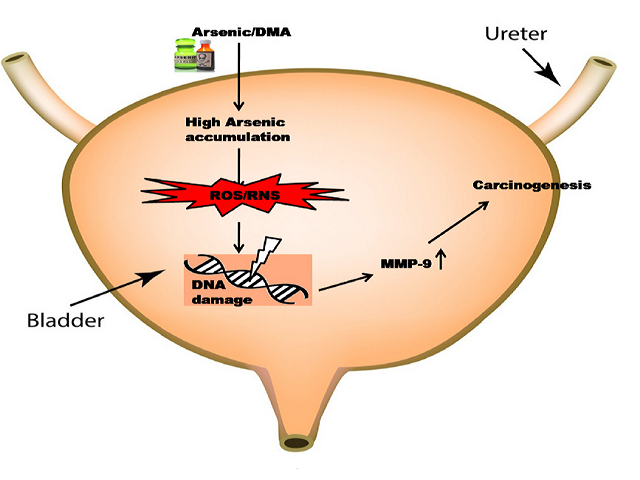Oxidative/ Nitrosative Stress, 8-OHdG and MMP-9: The Possible Co-Links and Early Sign of Arsenic Induced Urinary Bladder Carcinogenesis in Experimental Rats
DOI:
https://doi.org/10.5530/fra.2019.1.5Keywords:
Sodium arsenite and dimethylarsinic acid, Urinary bladder carcinogenesis, Oxidative/ Nitrosative stress, DNA damage, MMP-9Abstract
Background: Presently arsenicosis is considered as dangerous health issues including cancer. Urinary bladder is one of the common target organs for developing carcinogenesis by arsenic exposure due to accumulation of arsenic toxic metabolites in bladder. The mechanism involving urinary bladder carcinogenesis is still mysterious. Although there are multiple studies revealed about oxidative/nitosative stress, which plays main role for carcinogenesis, but no study evaluated the associated factor that linked with it as early sign to identify bladder carcinogenesis using a rat model. This study thus will be useful in predicting early sign for arsenic exposed urinary bladder carcinogenesis. Objective: We evaluated 8-Hydroxy-2-deoxyguanosine (8-OHdG) and Matrix Metalloproteinases-9 (MMP-9), which may be the possible associated factors along with oxidative/nitrosative stress as early sign for developing urinary bladder carcinogenesis upon arsenic and its metabolites exposure. Methods: Male Sprague Dawley rats were exposed to 25 ppm of sodium arsenite and its metabolite Dimethylarsinic Acid (DMA) via drinking water for a period of 16 weeks. The carcinogenic potentials were evaluated using various biochemical parameters indicative of oxidative/ nitrosative stress, ELISA of 8-OHdG as biomarker of oxidative/nitrosative stress induced DNA damage, which acts as a bridge between DNA damage and carcinogenesis. We also determined MMP-9 as potential pro-oncogenic biomarker associated with DNA damage. Results: High accumulation of arsenic was noted in tissues accompanied by a significant alteration of oxidative/nitrosative variables in liver and urinary bladder like significant changes in positive predictor of 8-OHdG and MMP-9 both in serum as well as urinary bladder tissue in animals exposed to arsenic and its metabolites. Conclusion: Early sign of urinary bladder carcinogenesis evaluated possibly by co-linking between oxidative/ nitrosative stress, 8-OHdG, MMP-9 and metal accumulation.
Downloads
Metrics





